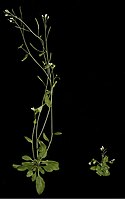
Photo from wikipedia
Background Tribenuron methyl (TBM) is an herbicide that inhibits sulfonylurea acetolactate synthase (ALS) and is one of the most widely used broad-leaved herbicides for crop production. However, soil residues or… Click to show full abstract
Background Tribenuron methyl (TBM) is an herbicide that inhibits sulfonylurea acetolactate synthase (ALS) and is one of the most widely used broad-leaved herbicides for crop production. However, soil residues or drifting of the herbicide spray might affect the germination and growth of rapeseed, Brassica napus , so it is imperative to understand the response mechanism of rape to TBM during germination. The aim of this study was to use transcriptome analysis to reveal the gene responses in herbicide-tolerant rapeseed to TBM stress during seed germination. Results 2414, 2286, and 1068 differentially expressed genes (DEGs) were identified in TBM-treated resistant vs sensitive lines, treated vs. control sensitive lines, treated vs. control resistant lines, respectively. GO analysis showed that most DEGs were annotated to the oxidation-reduction pathways and catalytic activity. KEGG enrichment was mainly involved in plant-pathogen interactions, α-linolenic acid metabolism, glucosinolate biosynthesis, and phenylpropanoid biosynthesis. Based on GO and KEGG enrichment, a total of 137 target genes were identified, including genes involved in biotransferase activity, response to antioxidant stress and lipid metabolism. Biotransferase genes, CYP450, ABC and GST , detoxify herbicide molecules through physical or biochemical processes. Antioxidant genes, RBOH, WRKY, CDPK, MAPK, CAT, and POD regulate plant tolerance by transmitting ROS signals and triggering antioxidant enzyme expression. Lipid-related genes and hormone-related genes were also found, such as LOX3, ADH1, JAZ6, BIN2 and ERF , and they also played an important role in herbicide resistance. Conclusions This study provides insights for selecting TBM-tolerant rapeseed germplasm and exploring the molecular mechanism of TBM tolerance during germination.
Journal Title: BMC Genomics
Year Published: 2021
Link to full text (if available)
Share on Social Media: Sign Up to like & get
recommendations!